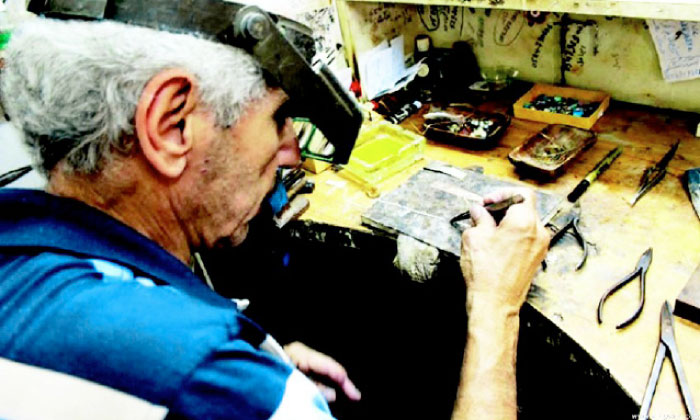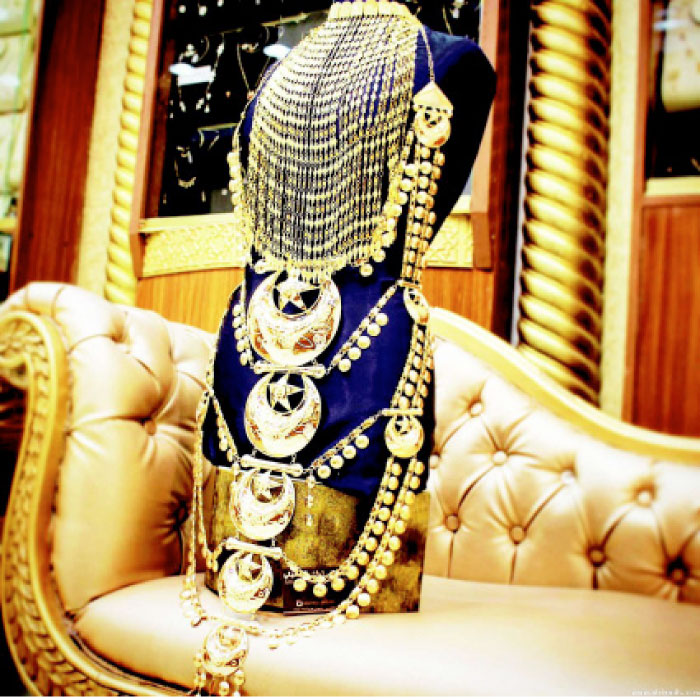The history of Saudi gold
05:52AM Fri 5 May, 2017

Saudi Gazette report | May 5,2017
GOLD has been used for coinage, jewelry and adornments throughout recorded history.
Goldsmithery is one of the oldest trades that showcased man’s artistic creativity. It can be traced back to the time of the pharaohs of Egypt.
 Requiring great skill and patience, today the Kingdom has goldsmithery institutes that teach the intricate technical and creative skills of the art, Al-Riyadh daily reports.
Gold is used in making jewelry and other ornaments. It is also commonly used in dentistry and electronics. One of the reasons gold is used in dentistry, especially as gold teeth, is because of its durability.
Requiring great skill and patience, today the Kingdom has goldsmithery institutes that teach the intricate technical and creative skills of the art, Al-Riyadh daily reports.
Gold is used in making jewelry and other ornaments. It is also commonly used in dentistry and electronics. One of the reasons gold is used in dentistry, especially as gold teeth, is because of its durability.
 As a metal, gold is soft but durable, particularly if combined with another non-toxic metal. Gold teeth are usually strong and last long.
The use of gold in electronics is due to its excellent electrical conductivity and reliability. It is used in conductors, switches, connecting wires and many other electronic components.
First gold mine
Gold was first mined in Arabia approximately 3000 BC. A second period of activity was during the Islamic Abbasid period between 750 and 1258 AD.
Extraction of gold started in the Kingdom during the era of King Abdulaziz, particularly between 1939 and 1954, at Mahd Al-Dhahab after the deposit was rediscovered in 1932.
The city, about 380 kilometers northeast of in Madinah province in the western region of the country, is situated at 1060 meters above sea level. Mining is carried out by underground methods with a total tunnel development in excess of 60km and a metallurgical plant.
Translated as the Cradle of Gold, Mahd Al-Dhahab was the first gold mine in the modern Saudi Arabia. In 2007, Mahd Al-Dhahab mined and processed approximately 183,425 tons of ore at a grade of 11.1 grams per ton of gold from underground operations, resulting in gold production of approximately 58,256 ounces.
In addition, the mine also processes reclaimed tailings and produces copper and zinc concentrates for third party toll smelting.
The Saudi government established the Saudi Arabian Mining Company in 1997 as a joint stock company with a capital of SR4 billion to operate five mines across the country. The company has expanded its business operations to include the development of phosphate, aluminum and other precious minerals.
Karat is the unit used to measure how pure a piece of gold is and it is abbreviated as “kt or K”. Usually, 24K gold is very expensive as it contains pure gold while 22K gold implies that 22 parts of the jewelry is gold and the remaining two parts are some other metal like silver, nickel, zinc and other alloys. The same thing applies to 18K gold, which consists of 18 parts of pure gold.
It is common for Saudi men to give their future wives dowry in gold. When a man proposes to a woman and when her parents and she accept, the man buys gold jewelry and presents it to his fiancée.
Gold remains the preferred gift for Saudi women even after marriage, especially during birthday parties, pregnancy parties and wedding anniversaries.
The Technical and Vocational Training Corporation (TVTC) offers diplomas in goldsmithery because the labor market is in dire need for goldsmiths, both men and women. The TVTC diploma program focuses on women because they are more likely than men to consider a life-long career in the field.
As a metal, gold is soft but durable, particularly if combined with another non-toxic metal. Gold teeth are usually strong and last long.
The use of gold in electronics is due to its excellent electrical conductivity and reliability. It is used in conductors, switches, connecting wires and many other electronic components.
First gold mine
Gold was first mined in Arabia approximately 3000 BC. A second period of activity was during the Islamic Abbasid period between 750 and 1258 AD.
Extraction of gold started in the Kingdom during the era of King Abdulaziz, particularly between 1939 and 1954, at Mahd Al-Dhahab after the deposit was rediscovered in 1932.
The city, about 380 kilometers northeast of in Madinah province in the western region of the country, is situated at 1060 meters above sea level. Mining is carried out by underground methods with a total tunnel development in excess of 60km and a metallurgical plant.
Translated as the Cradle of Gold, Mahd Al-Dhahab was the first gold mine in the modern Saudi Arabia. In 2007, Mahd Al-Dhahab mined and processed approximately 183,425 tons of ore at a grade of 11.1 grams per ton of gold from underground operations, resulting in gold production of approximately 58,256 ounces.
In addition, the mine also processes reclaimed tailings and produces copper and zinc concentrates for third party toll smelting.
The Saudi government established the Saudi Arabian Mining Company in 1997 as a joint stock company with a capital of SR4 billion to operate five mines across the country. The company has expanded its business operations to include the development of phosphate, aluminum and other precious minerals.
Karat is the unit used to measure how pure a piece of gold is and it is abbreviated as “kt or K”. Usually, 24K gold is very expensive as it contains pure gold while 22K gold implies that 22 parts of the jewelry is gold and the remaining two parts are some other metal like silver, nickel, zinc and other alloys. The same thing applies to 18K gold, which consists of 18 parts of pure gold.
It is common for Saudi men to give their future wives dowry in gold. When a man proposes to a woman and when her parents and she accept, the man buys gold jewelry and presents it to his fiancée.
Gold remains the preferred gift for Saudi women even after marriage, especially during birthday parties, pregnancy parties and wedding anniversaries.
The Technical and Vocational Training Corporation (TVTC) offers diplomas in goldsmithery because the labor market is in dire need for goldsmiths, both men and women. The TVTC diploma program focuses on women because they are more likely than men to consider a life-long career in the field.
 Requiring great skill and patience, today the Kingdom has goldsmithery institutes that teach the intricate technical and creative skills of the art, Al-Riyadh daily reports.
Gold is used in making jewelry and other ornaments. It is also commonly used in dentistry and electronics. One of the reasons gold is used in dentistry, especially as gold teeth, is because of its durability.
Requiring great skill and patience, today the Kingdom has goldsmithery institutes that teach the intricate technical and creative skills of the art, Al-Riyadh daily reports.
Gold is used in making jewelry and other ornaments. It is also commonly used in dentistry and electronics. One of the reasons gold is used in dentistry, especially as gold teeth, is because of its durability.
 As a metal, gold is soft but durable, particularly if combined with another non-toxic metal. Gold teeth are usually strong and last long.
The use of gold in electronics is due to its excellent electrical conductivity and reliability. It is used in conductors, switches, connecting wires and many other electronic components.
First gold mine
Gold was first mined in Arabia approximately 3000 BC. A second period of activity was during the Islamic Abbasid period between 750 and 1258 AD.
Extraction of gold started in the Kingdom during the era of King Abdulaziz, particularly between 1939 and 1954, at Mahd Al-Dhahab after the deposit was rediscovered in 1932.
The city, about 380 kilometers northeast of in Madinah province in the western region of the country, is situated at 1060 meters above sea level. Mining is carried out by underground methods with a total tunnel development in excess of 60km and a metallurgical plant.
Translated as the Cradle of Gold, Mahd Al-Dhahab was the first gold mine in the modern Saudi Arabia. In 2007, Mahd Al-Dhahab mined and processed approximately 183,425 tons of ore at a grade of 11.1 grams per ton of gold from underground operations, resulting in gold production of approximately 58,256 ounces.
In addition, the mine also processes reclaimed tailings and produces copper and zinc concentrates for third party toll smelting.
The Saudi government established the Saudi Arabian Mining Company in 1997 as a joint stock company with a capital of SR4 billion to operate five mines across the country. The company has expanded its business operations to include the development of phosphate, aluminum and other precious minerals.
Karat is the unit used to measure how pure a piece of gold is and it is abbreviated as “kt or K”. Usually, 24K gold is very expensive as it contains pure gold while 22K gold implies that 22 parts of the jewelry is gold and the remaining two parts are some other metal like silver, nickel, zinc and other alloys. The same thing applies to 18K gold, which consists of 18 parts of pure gold.
It is common for Saudi men to give their future wives dowry in gold. When a man proposes to a woman and when her parents and she accept, the man buys gold jewelry and presents it to his fiancée.
Gold remains the preferred gift for Saudi women even after marriage, especially during birthday parties, pregnancy parties and wedding anniversaries.
The Technical and Vocational Training Corporation (TVTC) offers diplomas in goldsmithery because the labor market is in dire need for goldsmiths, both men and women. The TVTC diploma program focuses on women because they are more likely than men to consider a life-long career in the field.
As a metal, gold is soft but durable, particularly if combined with another non-toxic metal. Gold teeth are usually strong and last long.
The use of gold in electronics is due to its excellent electrical conductivity and reliability. It is used in conductors, switches, connecting wires and many other electronic components.
First gold mine
Gold was first mined in Arabia approximately 3000 BC. A second period of activity was during the Islamic Abbasid period between 750 and 1258 AD.
Extraction of gold started in the Kingdom during the era of King Abdulaziz, particularly between 1939 and 1954, at Mahd Al-Dhahab after the deposit was rediscovered in 1932.
The city, about 380 kilometers northeast of in Madinah province in the western region of the country, is situated at 1060 meters above sea level. Mining is carried out by underground methods with a total tunnel development in excess of 60km and a metallurgical plant.
Translated as the Cradle of Gold, Mahd Al-Dhahab was the first gold mine in the modern Saudi Arabia. In 2007, Mahd Al-Dhahab mined and processed approximately 183,425 tons of ore at a grade of 11.1 grams per ton of gold from underground operations, resulting in gold production of approximately 58,256 ounces.
In addition, the mine also processes reclaimed tailings and produces copper and zinc concentrates for third party toll smelting.
The Saudi government established the Saudi Arabian Mining Company in 1997 as a joint stock company with a capital of SR4 billion to operate five mines across the country. The company has expanded its business operations to include the development of phosphate, aluminum and other precious minerals.
Karat is the unit used to measure how pure a piece of gold is and it is abbreviated as “kt or K”. Usually, 24K gold is very expensive as it contains pure gold while 22K gold implies that 22 parts of the jewelry is gold and the remaining two parts are some other metal like silver, nickel, zinc and other alloys. The same thing applies to 18K gold, which consists of 18 parts of pure gold.
It is common for Saudi men to give their future wives dowry in gold. When a man proposes to a woman and when her parents and she accept, the man buys gold jewelry and presents it to his fiancée.
Gold remains the preferred gift for Saudi women even after marriage, especially during birthday parties, pregnancy parties and wedding anniversaries.
The Technical and Vocational Training Corporation (TVTC) offers diplomas in goldsmithery because the labor market is in dire need for goldsmiths, both men and women. The TVTC diploma program focuses on women because they are more likely than men to consider a life-long career in the field.











